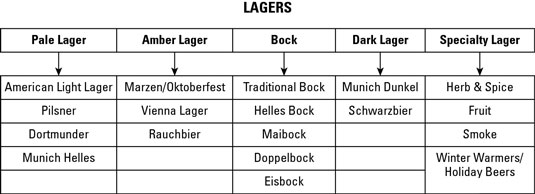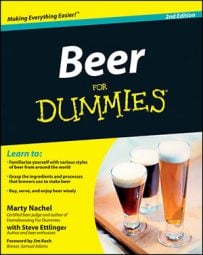The name lager is taken from the German word lagern, meaning "to store." Most of the mass-produced beers of the world are lagers, but a wider range of styles exists than what those commercial brands may lead you to believe.
-
American Pale Lagers: Although these beers differ greatly from brand to brand in the mind of the unknowing consumer (thanks to advertising campaigns), they’re, for the most part, identical in taste and strength (about 4 to 5 percent alcohol by volume). They’re light-colored, gassy, and watery, with a delicate sweetness and an adjunct (corn or rice is the adjunct grain mixed with the barley) aroma and flavor (light versions have almost no taste or aroma). Primarily thirst quenchers, they’re designed to be served very cold.
-
American Dark Lagers: These lagers are timid versions of European exemplars. They lack the fullness and rich, malty flavor of the German Dark Lager style and have more bark than bite.
-
Bock Beer: Traditional Bock Beers are generally dark, somewhat strong, and pretty intensely malty.
-
Doppelbock: A dark and dangerously delicious malty brew of rich body and high alcohol, Doppelbock was first brewed in the Italian Alps by the monks in the monastery of St. Francis of Paula for sustenance throughout the Lenten season.
-
Dortmunder Export: This bright golden lager offers the maltiness of a Munich Helles and the hoppiness of a Pilsner, and it’s slightly stronger than both. The term export refers to the beer’s alcoholic strength and can be applied to other beer styles as well.
-
Eisbock: An anomaly in the brewing world, Eisbock (ice bock) doesn’t come by its full body and high alcohol content naturally. By subjecting the already fermented beer to subfreezing temperatures, brewers can then sieve out the water crystals that form in the beer. The beer that’s left behind is a much more concentrated version of itself (7 to 33 percent concentration).
-
Helles Bock: This beer is a pale version of traditional Bock Beer (Helles means pale).
-
Maibock: Maibock is a nod to the month it’s brewed in (Mai is May). These paler, hoppier versions of Bock Beer are a fairly recent development in comparison to other members of the Bock Beer family.
-
Märzenbier/Oktoberfest Beers: Märzenbier is malt-forward, amber in color, and very easy to drink. It was traditionally brewed in the month of March (Marz) at the end of the brewing season, stored in caves over the summer, and served in autumn amidst harvest celebrations. Märzenbier eventually became the official beer of Oktoberfest.
-
Munich Dunkel: This classic brown lager of Munich was developed as a darker, maltier counterpart to Munich Helles.
-
Munich Helles: A pale (Helles means pale) lager, Munich Helles is malty-sweet and clean on the palate.
-
Pilsner (also spelled Pils, Pilsener, and in the Czech Republic, Plzensky): Pilsner is the authentic beer from the Czech Republic that many American brand-name beers aspire to be: an aromatic, subtly malty, crisp, and refreshingly bitter (hoppy) lager.
Rauchbier (Smoked Beer): The Rauchbier can range from a friendly campfire-like smokiness to an intense and acrid pungency. It’s definitely an acquired taste.
-
Schwarzbier: The Schwarzbier is a regional specialty beer from northern Bavaria. It’s believed to be a variant of the Munich Dunkel style but darker and drier (less sweet) on the palate. Some people liken Schwarzbier to a black Pilsner.
-
Vienna Lager: The Vienna Lager is the malty, amber-colored, medium-bodied cousin of Märzenbier. Vienna Lager is actually more abundant and visible in Mexico than its home country of Austria, due to Emperor Maximilian’s rule there back in the 1800s.


